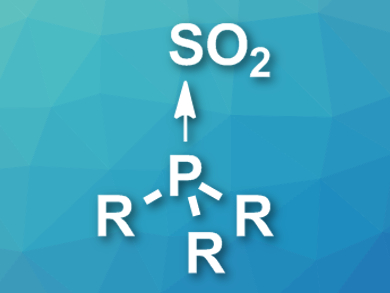Sulfur dioxide is a useful reagent for inorganic and organic syntheses. However, it is a toxic gas and, thus, hard to handle. One approach to solve this problem is the preparation of solid adducts of SO2 with bases. Such adducts have been prepared using nitrogen bases. In contrast, no adducts between phosphines and SO2 had been synthesized so far.
Fabian Dielmann and colleagues, University of Münster, Germany, have synthesized the first phosphine–SO2 adducts (pictured). The team used phosphines with imidazolin-2-imine substituents, strong π-donors that increase the electron-donating character of the phosphine. These electron-rich phosphines were dissolved in benzene and subjected to gaseous SO2 at a pressure of 2 bar. The gaseous SO2 could also be replaced with stoichiometric amounts of a nitrogen base–SO2 adduct. The team characterized the resulting phosphine–SO2 adduct using 31P NMR spectroscopy and single crystal X-ray diffraction.
The adduct features a pyramidal P→SO2 unit and is stable at room temperature. However, when other, less electron-donating substituents are used at the phosphine, the corresponding SO2 adducts decompose at room temperature. In these compounds, SO2 is activated and sulfur monoxide (SO) is released, resulting in the formation of phosphine oxides. Due to the high reactivity of SO, it can further react with intact phosphine–SO2 adducts, which leads to a mixture of decomposition products. According to the researchers, further studies on the possible use of phosphine–SO2 adducts as SO-transfer reagents are in progress.
- Crystalline, Room-Temperature Stable Phosphine–SO2 Adducts: Generation of Sulfur Monoxide from Sulfur Dioxide,
Florenz Buß, Philipp Rotering, Christian Mück-Lichtenfeld, Fabian Dielmann,
Dalton Trans. 2018.
https://doi.org/10.1039/c8dt01484a




